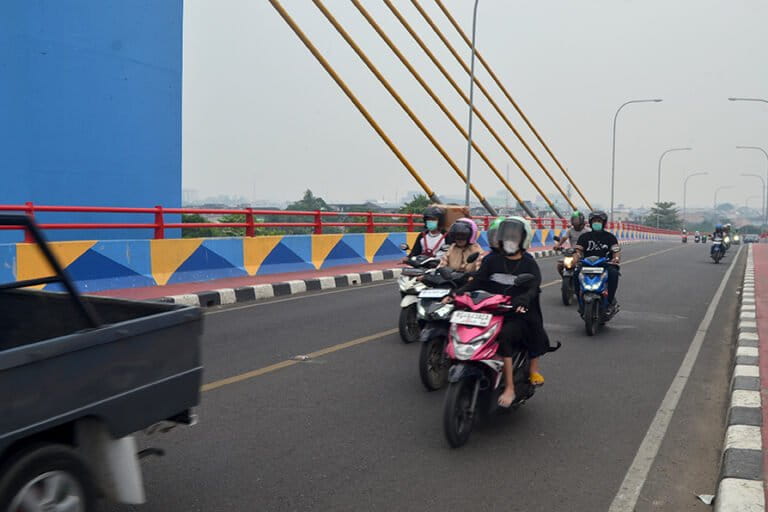Sumatran province hangs on for late rain as El Niño fires bring heat and sickness
Sep 28, 2023
- Wildfires have returned to Indonesia as the country enters its dry season amid an El Niño year.
- In Palembang city, new respiratory infections will likely soon eclipse the total diagnosed in 2022.
- Meteorology officials expect the monsoon to begin in parts of Sumatra and Borneo islands in October, but warn dry conditions will persist in much of Indonesia until November.
New acute respiratory infections in Indonesia’s Palembang city, on the island of Sumatra, are on track to surpass the total number recorded there in 2022, as firefighters scramble to confront wildfires brought on by this year’s El Niño dry season.
The health department in Palembang, the capital of South Sumatra province, said health workers in the city had diagnosed 9,948 new respiratory tract infections in September up to the third week of the month, higher than the number diagnosed for the entire month of June.
“If you need to do activities outside the home, it is best to wear a mask,” Yudhi Setiawan, infectious diseases lead at the city’s health department, said as cases rose in early September.
Palembang, the main population center in South Sumatra, is home to almost 2 million people. The city is located about 500 kilometers (300 miles) south of Singapore on Sumatra’s Musi River. Palembang is surrounded by oil palm and acacia plantations cultivated on extensive peatlands, where wildfires can burn most intractably, in the nearby districts of Ogan Komering Ulu and Ogan Komering Ilir.
Yudhi linked the number of respiratory cases to the emergence of dry-season air pollution.
Indonesia’s meteorology agency reported 942 hotspots across Sumatra on Sept. 23, with more than 60% located in just South Sumatra province.
The number of infections recorded in Palembang in the year to mid-September was 81% of the total number recorded in the city during all of 2022. Infections from June to August were 30% higher than during the same period in 2022.

Indonesia’s meteorology agency expects the end of the dry season in South Sumatra is still several weeks away owing to the combination of a positive Indian Ocean Dipole and El Niño.
The Palembang health department recorded 1,493 new respiratory illnesses from Sept. 1-9 in children under the age of 5, according to daily data. This group accounted for 30% of all acute respiratory tract infections during the Sept. 1-11 period, the data showed, reflecting the disproportionate vulnerability borne by very young children from wildfire pollution.
In 2018, more than 19,000 children under the age of 5 died in Indonesia from preventable pneumonia, equivalent to two deaths every hour, according to UNICEF, the U.N. children’s agency. In 2017, pneumonia was the second-leading cause of death among children in Indonesia.
Research shows that a large share of pneumonia deaths in children is attributed to persistent indoor burning of fuels to boil water and light homes in rural areas. But hazardous air quality due to wildfire pollution is a prominent seasonal risk of illness in regional capitals across Sumatra and Indonesian Borneo, such as Palembang, Palangkaraya, Pekanbaru and Pontianak.
One study by Harvard and Columbia universities suggested wildfires in 2015 could be at fault for almost 100,000 early deaths in Indonesia.
Anecdotal testimony from parents and schoolteachers in Palembang indicates anxiety over child welfare in the city, as officials mulled whether to implement remote learning for schoolchildren.
“Every time my child goes to school, I always require them to wear a mask,” Dwi Apriyani, a 34-year-old mother from Palembang, told national newspaper Kompas.

In the first week of September, the lead of the city’s meteorology office suggested that Palembang’s schools should be shuttered and teaching conducted online, a policy the city government enacted during Indonesia’s 2019 wildfire crisis — around six months before schools across the archipelago were closed for two years following the onset of the COVID-19 pandemic.
A World Bank study has estimated that school closures cut Indonesia’s Programme for International Student Assessment (PISA) score, a global standard to measure literacy and numeracy among 15-year-old pupils, by 25-35 points.
Rain delay
The head of Indonesia’s meteorology agency (BMKG), Dwikorita Karnawati, told a press conference on Sept. 8 that forecasters continued to expect the arrival of Indonesia’s rainy season to be delayed by weeks owing to a positive Indian Ocean Dipole, which cools water in the eastern Indian Ocean, combined with El Niño, which warms water in the Pacific.
“These reinforce each other,” Dwikorita said. “In other words, the superposition of the El Niño and IOD phenomena causes the formation of rainclouds in Indonesia to be much less than normal.”
BMKG forecasters say the rainy season will likely arrive for some fire-affected areas of Borneo and Sumatra over the course of October.
However, for Dwi Apriyani and other parents in South Sumatra, rains are not expected to arrive until November, likely sustaining higher health risks in Palembang for at least another month.
“The air quality in Palembang is increasingly concerning,” Dwi said.
Banner image: Haze rising from an oil palm plantation and forest in Riau province. Image by Rhett A. Butler / Mongabay.
El Niño leads to more fires and toxic air pollution in Indonesia
Citation:
Syuhada, G., Akbar, A., Hardiawan, D., Pun, V., Darmawan, A., Heryati, S. H. A., … Mehta, S. (2023). Impacts of Air Pollution on Health and Cost of Illness in Jakarta, Indonesia. International Journal of Environmental Research and Public Health, 20(4), 2916. doi:10.3390/ijerph20042916